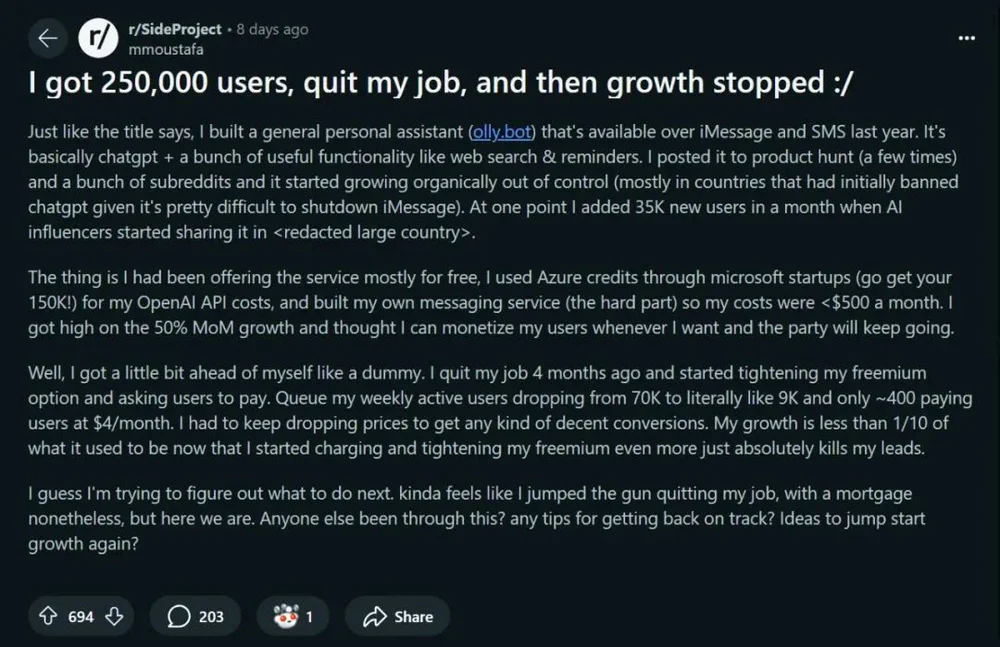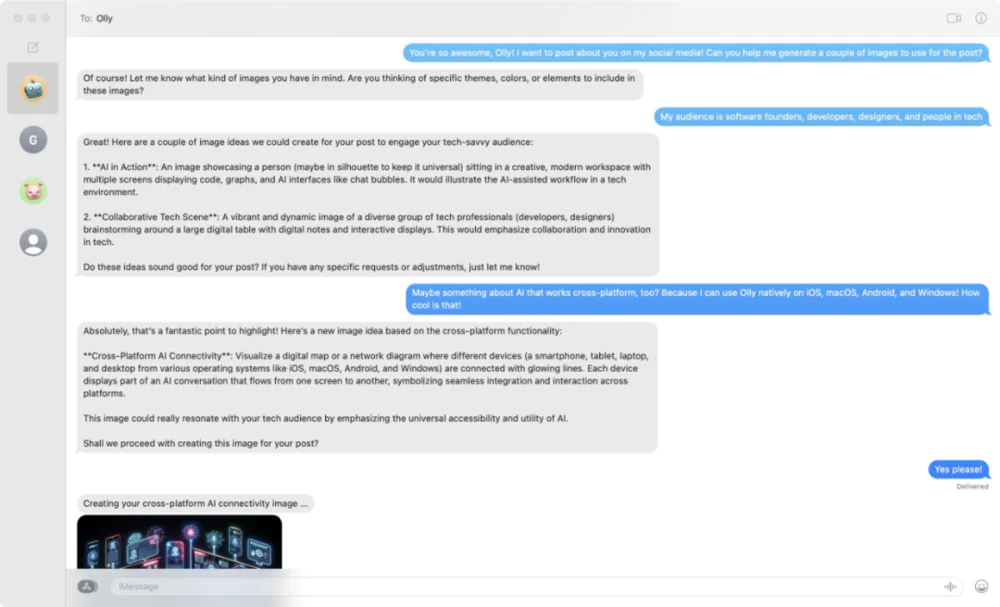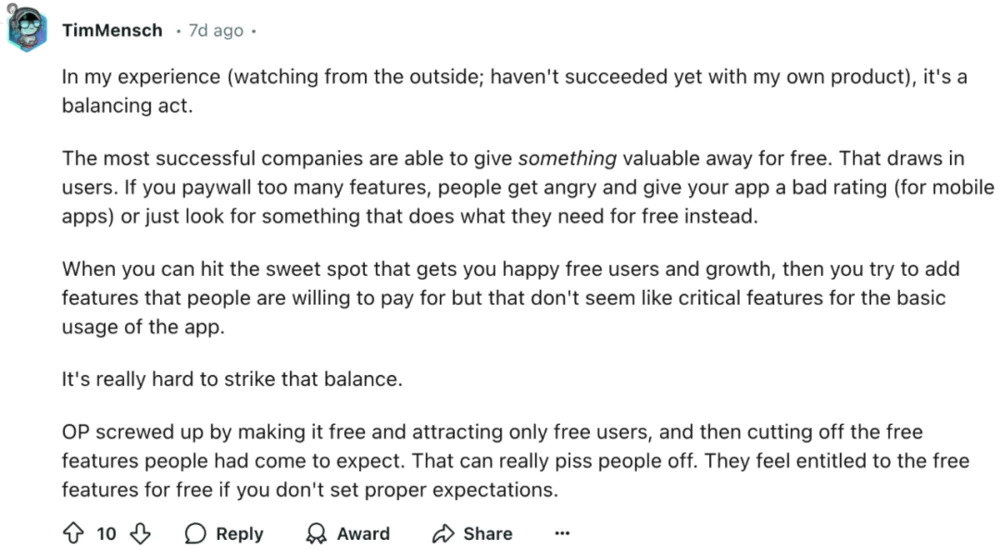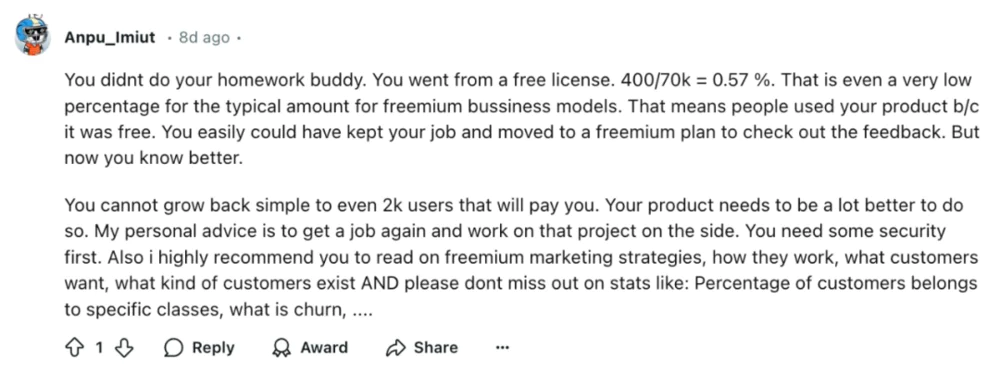In the past few days, a tragic programmer's entrepreneurial story has been circulating on social networks, causing people to think deeply.

The protagonist of the story, Reddit user mmoustafa, started developing a universal AI personal assistant "olly.bot" that can be used through iMessage and SMS as a side job last year. It is based on OpenAI's large model, and also has a series of convenient and useful functions, such as web search and reminders.
olly.bot hits users' pain points precisely, and the app is integrated with iMessage and WhatsApp, which means you can use it natively on iOS, macOS, Android, and Windows. Specifically, it can view pictures, read PDFs, listen to voice memos, generate pictures, browse web pages, etc. As development continues, its capabilities are constantly increasing.

There is no need to register, there are almost no regional restrictions of ChatGPT, it can be connected to the Internet and it is free, which looks very attractive.
In order to promote his project, the author kept posting it on product hunt and many Reddit boards, and its user base soon began to grow wildly. When some big names in AI started sharing it on <redacted large country>, the app once gained 35,000 new users in a month.
A large model tool that has been free in the process of attracting users has put pressure on the production staff. The author has been using Azure credits through Microsoft Startups to cover the cost of the OpenAI API and built his own messaging service (this is the hard part) , so the server cost is less than $500 per month.
Finally, the author feels confident about the 50% monthly growth. It should continue to grow and start making money.
Four months ago, this person quit his job and started his own business. How should star AI applications be monetized? He chose a "normal path": reducing the free version of the service and requiring users to pay for membership to experience the full version.
As a result, his weekly active users dropped from 70,000 to 9,000 in an instant, and there were only about 400 paying users of $4 per month. Faced with bleak business, he had to keep cutting prices to get a decent conversion rate. After charging started, olly.bot's growth rate was less than 1/10 of what it was when it was free, and potential users were obviously scared away.
What now? I have quit my job, my app has gone out of business, and I still owe a mortgage. Do you have any tips for getting back to life? Please give me some advice.
Netizen: There is something wrong with your strategy
A really popular app suddenly died as soon as you started paying for it. This experience really makes many people who are determined to start a business feel a chill in the back.
On social networks, while sighing, everyone is also offering suggestions.
Some netizens said: "Never make free products pay. You should launch paid products from the beginning, or conduct trials to let people know that they must pay after the trial period." The author agreed very much and said: "The product meets market demand (Product / Market Fit (PMF) should actually be that the product price (Price) meets market demand.”

But the problem is "if you pay in full from the beginning, you may never get 1,000 users." Indeed, the premise for paying for an application is that users think the application has value. If the application is fully paid as soon as it is launched, users may not even have a chance to use it.

Of course, there are some strategies to choose from, such as a free paid package with a trial period; a permanent free package with practical features in the paid package; and a higher-level package for enterprises.
In general, product payment needs to find a balance point . If you set up too many paid features, people will get angry and give the app negative reviews, or simply look for an app that meets their needs for free. When you reach the sweet spot of satisfying your free users and growing, you can try adding features that people will pay for.

These suggestions are very reasonable, and mmoustafa, the author of olly.bot, also responded to them one by one and expressed his gratitude. But as you can see, for the current situation, a lot of it is an afterthought, and there don't seem to be many ways to break the situation.
One netizen pointed out: “The author’s application has 70,000 weekly active users, and only about 400 paying users of $4 per month, 400/70k ≈ 0.57%, which is very low for a freemium business model. That means people are using the product because it's free... My personal advice would be to find another job and work on the project in my spare time."

You can have hobbies, but in any case, let’s go back to work in a factory first.
Writing an app to start a business is harder than you think
In March last year, OpenAI launched the ChatGPT API and charged based on usage. The price of a single call dropped by 90% compared with the previous generation. This allowed many individual developers to find ways to commercialize new technologies.
In people's vision, around advanced large model technology, a series of applications that provide various services may appear in the future. Developers who call the large model API do not need to pay attention to expensive large model technology, and large model manufacturers do not need to pay attention to all subdivided scenarios.
However, so far, although the APIs provided by various large model companies have been reduced in price for several rounds, there have been few examples of people making money through large model applications.
What is even more concerning is that OpenAI’s ChatGPT search was officially released last Thursday. In addition to members and users on the SearchGPT waiting list, users of the free version will also receive access in the future.
The big factory's harvest came unexpectedly, but if you think about it carefully, it was expected.